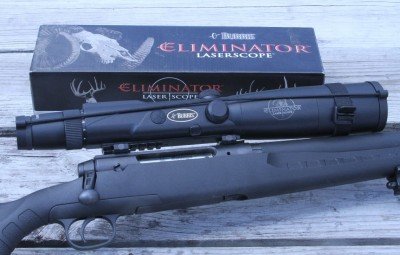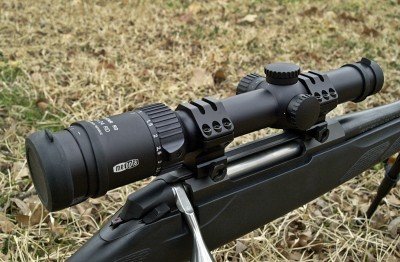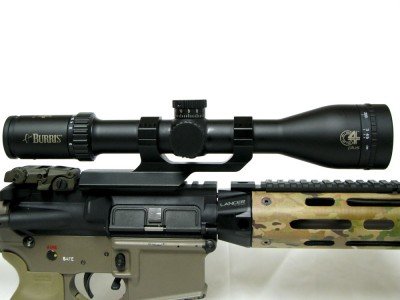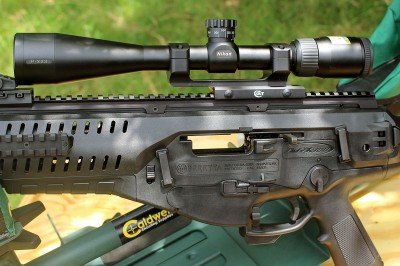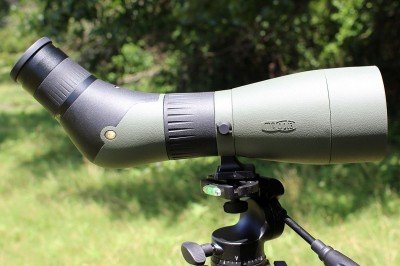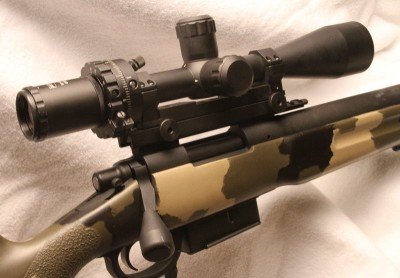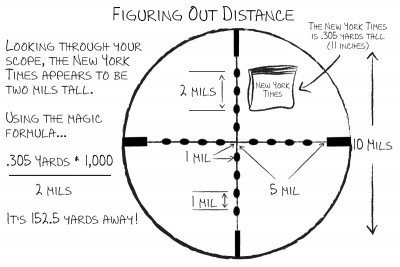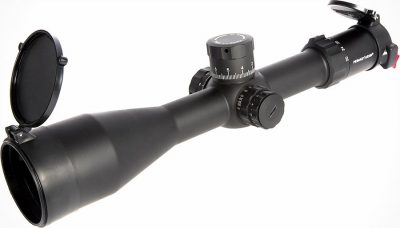Bullet drop, and compensating for it, can be extremely confusing, even for those of us who are good in math. But bullet drop itself isn’t that complicated, especially if you always use the same factory ammo with the same bullet from the same manufacturer. Nikon took this realization, concept, whatever you want to call it, to the next level in their M-223 series and designed scopes that are specifically for the bullet drop of the .223/5.56 NATO cartridge. Read More…
Scopes
Show First
Burris Eliminator Laserscope – Rangefinder Built In!
Updated: August 26, 2012Blowing the shot can be caused by a lot of things. You may not have zeroed your rifle properly. You may not have been able to get a steady rest in time, or more often than not, you may have figured out the wrong holdover. Even the best shooter, given the pressure of a shot that needs to be shot right now, can blow a big shot, without even having to do quick math and calculate a holdover. Anyone can blow a shot, all factors considered, so any advantage you can pick up from your gear, the better.
We have covered several “rangefinding” scopes in the past. Some require math and some don’t, but by far the most advanced range estimating scope out there is the Burris Eliminator Laserscope. It has a built in rangefinder, and after you set it up for the ballistics of your rifle and cartridge, it gives you a .33 MOA dot for exact holdover. Sounds too good to be true right? At a pricetag of $949 MSRP, this is not an inexpensive toy mind you, but it does work. We got a chance to put the Burris Eliminator through its paces, and it works pretty good actually
Meopta MeoStar R2 1-6×24 RD Riflescope Hits it Over the Fence
Updated: March 14, 2014Thanks to modern manufacturing processes, today’s rifles have accuracies of one to two minutes of angle right out of the box. However, if you want to realize that potential, you’ll need a scope that’s in the same ballpark. The hard part, of course, is deciding which of the multitude of scopes in the marketplace is best for you. After all, they all look pretty much the same. But when you look a little closer, the differences begin to emerge. I don’t generally get too excited about scopes, but as an astronomy buff and licensed optician, when I get to use an optical instrument of this caliber, it’s hard not to get excited.
Meopta, an American family-owned, multinational company with headquarters in the US, has been building scopes since 1933. Although the company is not well known here, you’ve certainly heard of some of the premium scope makers it has built scopes for. The point is, Meopta has a lot of experience manufacturing top-of-the-line scopes.
Burris C4Plus Riflescope—New Scope Review
Updated: March 28, 2014When I first got into shooting there wasn’t the wide variety of scopes and reticles to choose from that we enjoy today. While the elements that make up a riflescope haven’t changed in many years, the technology and features have changed and continue to do so. I believe that we’re now at a point where there is literally an optic for just about any shooting activity to meet just about anyone’s budget. Hunting scopes probably have the largest market share when it comes to the total number of optics sold, but they also have the fewest features to offer the shooter. The typical hunting scope is a pretty simple affair with covered turrets and a simple duplex reticle for aiming. For most shooters, this arrangement works well for those shots that don’t fall outside of 200 yards across the fields or in the backwoods. However if a shot has to be pushed past that distance, the only choices are to apply some Kentucky windage and hope you know the drop of the ammunition well enough or to attempt to close the gap.
This year, Burris released a new line of hunting scopes called C4Plus that provides options for shooters looking for more versatility from their optics in an affordable package. Featuring two popular variable magnification ranges, custom bullet drop compensating knobs, quality glass and a new reticle specifically designed for wind compensation, these scopes have the potential to reach past the hunting scope market. At first glance it appears that Burris has done its homework in the design and layout of these scopes, so lets take a closer look.
Nikon’s Dedicated AR-15 Scopes: the P223 4-12×40
Updated: August 3, 2014The Nikon P223 4-12×40 is a purpose built scope meant to handle the specific needs of long range AR shooter. The scope is designed around 55 grain, polymer tipped, .223 bullets. It is the longest of the Nikon AR scopes, and sets up some ambitious goals for the modern sporting rifle platform. But the price is right.
The Meopta MeoPro 80 HD Spotting Scope
Updated: September 26, 2014If you are a serious shooter, a good spotting scope is a must. I see people shooting long range all the time, then trying to check their shots through a rifle scope. But if I were to make a list of gear I have to have to do my reviews efficiently, this would be in the top five, right up there with my ear protection, my bench rest, and my box of screwdrivers. Lately, it has been the Meopta MeoPro 80 HD.
Leatherwood ART M-1000 Auto-Ranging Riflescope
Updated: October 24, 2014When it comes to shooting gadgets it is very seldom that I want to jump up and down on my roof and yell “look at this look at this look at this!” But this is the way I feel about the Leatherwood M-1000 scope. I almost wish it was a $2,000 thing, because people would take it more seriously, but though it is based on technology going all the way back to 1970, and the MSRP is $459, with a generalstreet price under $400, it is one of the most excitingly nerdy thingamajigs I have ever encountered in the shooting world. It may be a little ugly compared to the more elegant scopes of today, but this largish awkward looking scope can give you the ability to “frame, aim and shoot, ” point of aim, point of impact between 100 and 1000 meters without ever having to lift your eye from the eyepiece. And you can change from one load to the next, or even one rifle to the next with two minor adjustments. Does that totally rock or does that totally rock?
Advanced Mil-Dot: Estimating Distance Using Your Scope
Updated: March 31, 2024Break out the calculators–we’re doing some math. This isn’t count-on-your-fingers math, either. We’re talking about the Mil-Dot reticle scope and its use. And this is valuable information for anyone who shoots long range. This isn’t Mil-Dot Made Easy–we’ve done that one already. This is the advanced lesson.
Red Dots vs. Magnified Scopes: Which Tactical Optic Is Right For You?
Updated: June 28, 2016I hate to kill a sacred cow for all you tactical ninjas out there, but in most cases a magnified optic is better than a red dot.
Primary Arms Platinum Scopes Are Here and Looking Good
Updated: March 31, 2024Primary Arms has a new higher-end series of riflescopes called the Platinum Series. The Platinum series is a big departure from their increasingly popular budget optics but that doesn’t make it any less of a value.
